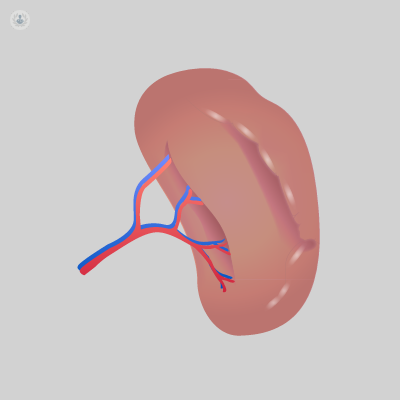

What is spleen removal surgery?
The spleen is a small, fist-sized organ located underneath left rib cage, close to the stomach. The spleen is a key component of the immune system as it contains white blood cells that kill bacteria and fight infections. The spleen also filters out old red blood cells from the bloodstream.
Spleen removal surgery is called a partial splenectomy if just part of the spleen is removed, or a splenectomy if the whole spleen is removed.

Why would you need spleen removal surgery?
The reasons you might need a splenectomy include:
- A ruptured spleen – which could be caused by injury and can lead to internal bleeding which could be life-threatening.
- Cancer involving the spleen – cancers that affect the blood cells, such as leukaemia or lymphoma, will likely result in the spleen needing to be removed.
- Certain diseases – such as sickle cell disease can cause the spleen to stop functioning, and it therefore needs removing.
- Infection – if an infection around the spleen does not clear up with other treatments, then a splenectomy will be recommended.
What does it involve?
Splenectomies can either be performed laparoscopically (keyhole surgery) or as open surgery. Most are carried out laparoscopically.
During a laparoscopic splenectomy, a special instrument guided by a camera is inserted via small incisions and allows the surgeon to access the abdomen and spleen without the need to make large cuts and scars. General anaesthetic is still required for this type of splenectomy.
Open surgery involves a large cut being made in the abdomen, to allow the extraction of the spleen. Open surgery is usually chosen if the spleen is very damaged or large and will often be done in an emergency case. General anaesthetic is also required.
How to prepare for it
Before surgery, you may be advised to stop taking certain medications, avoid eating and drinking, receive certain vaccines to prevent infection after the spleen is removed, and it may be necessary to have a blood transfusion to ensure that you have enough blood cells post-splenectomy.
Post-operative care
After a laparoscopic splenectomy, the small incisions are either stitched together or glued. Often patients are able to leave the same day or the following day. If the patient does return the same day, it is necessary for them to be accompanied by a family member or friend.
After an open surgery splenectomy, it will be necessary to stay in hospital for two to six days. It is normal to feel some pain, which can be managed with painkillers. During the hospital stay, you will be given some exercises to keep moving, to avoid blood clots. You can expect to recover and return to normal activities within six weeks.
Once you have healed fully, the other organs in the body are able to take over the functions that the spleen performed, however, you can be more prone to infection and sickness.
